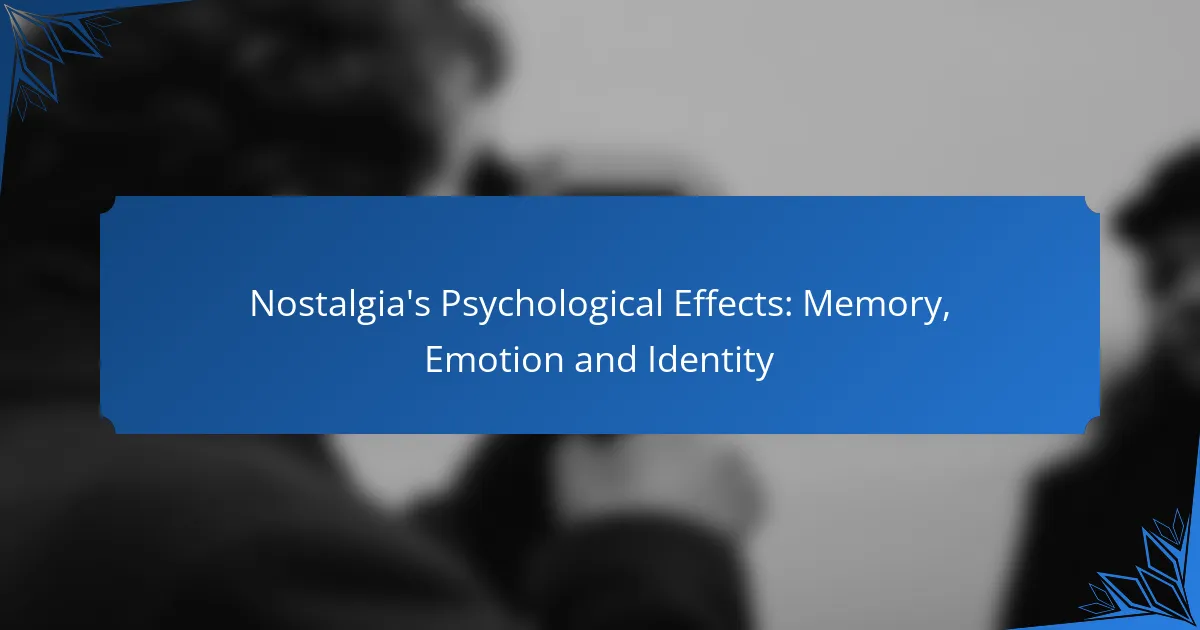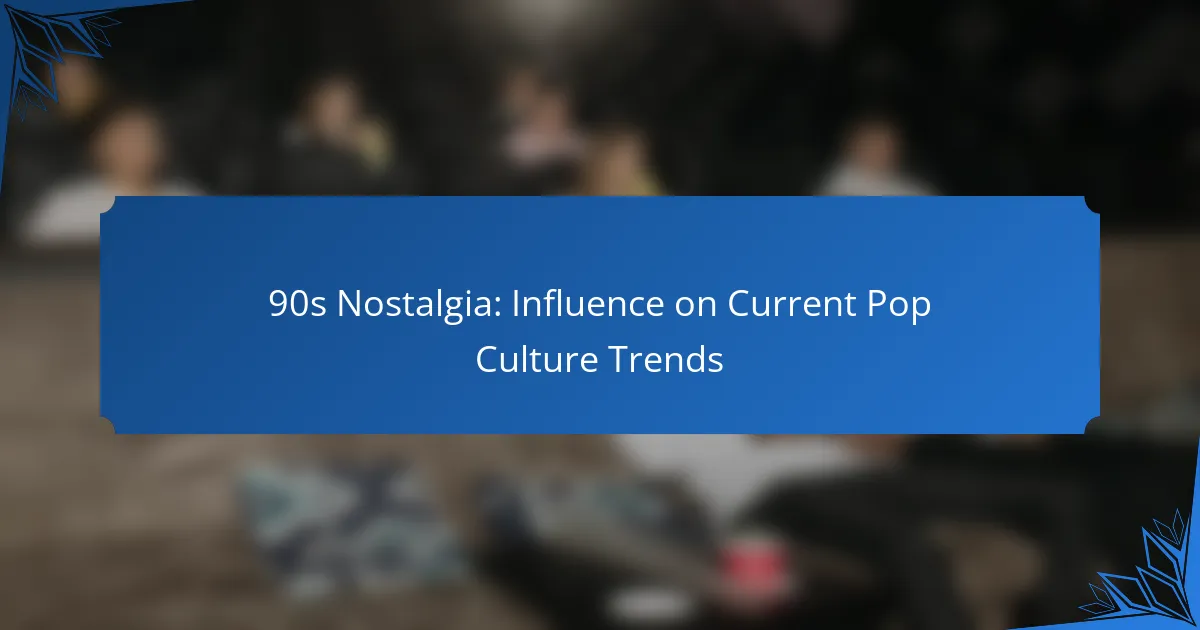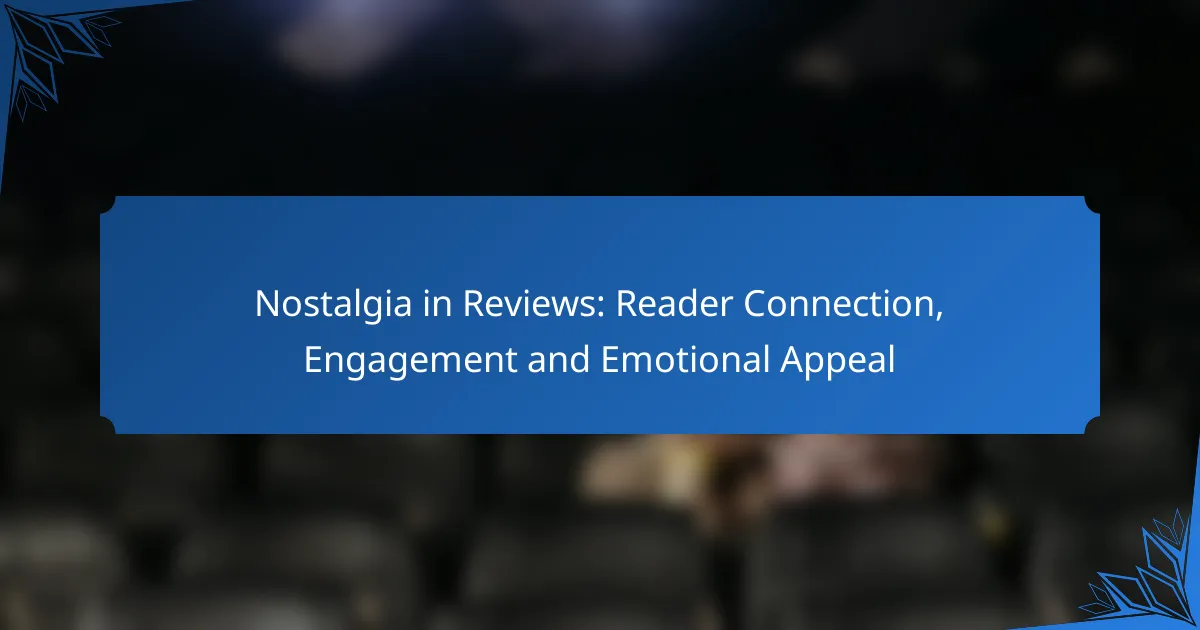Nostalgia is a powerful psychological phenomenon that enhances memory recall by infusing past experiences with vivid emotions. This emotional resonance not only enriches the details of memories but also elevates feelings of happiness while alleviating loneliness. Furthermore, nostalgia plays a crucial role in shaping personal identity, fostering a sense of continuity and belonging through the integration of cherished memories into one’s self-concept.

How does nostalgia impact memory recall?
Nostalgia significantly enhances memory recall by making past experiences more vivid and emotionally charged. This emotional connection can lead to a stronger and clearer recollection of specific events, often enriching the details associated with those memories.
Enhances vividness of memories
Nostalgia can amplify the vividness of memories, making them feel more real and immediate. When individuals reflect on nostalgic experiences, they often report heightened sensory details, such as sights, sounds, and smells, which can create a more immersive recollection.
This enhancement occurs because nostalgia often evokes strong emotions, which are known to improve the encoding and retrieval of memories. For instance, a song from one’s youth may trigger a flood of memories associated with that time, making them feel more alive and accessible.
Triggers autobiographical memories
Nostalgia is particularly effective at triggering autobiographical memories, which are personal memories tied to one’s life story. These memories often include significant life events, relationships, and milestones that shape an individual’s identity.
For example, reminiscing about childhood holidays can bring back specific moments, such as family gatherings or favorite toys, reinforcing a sense of self and continuity over time. Engaging with nostalgic triggers, like old photographs or familiar scents, can facilitate this recall, allowing individuals to connect with their past more deeply.
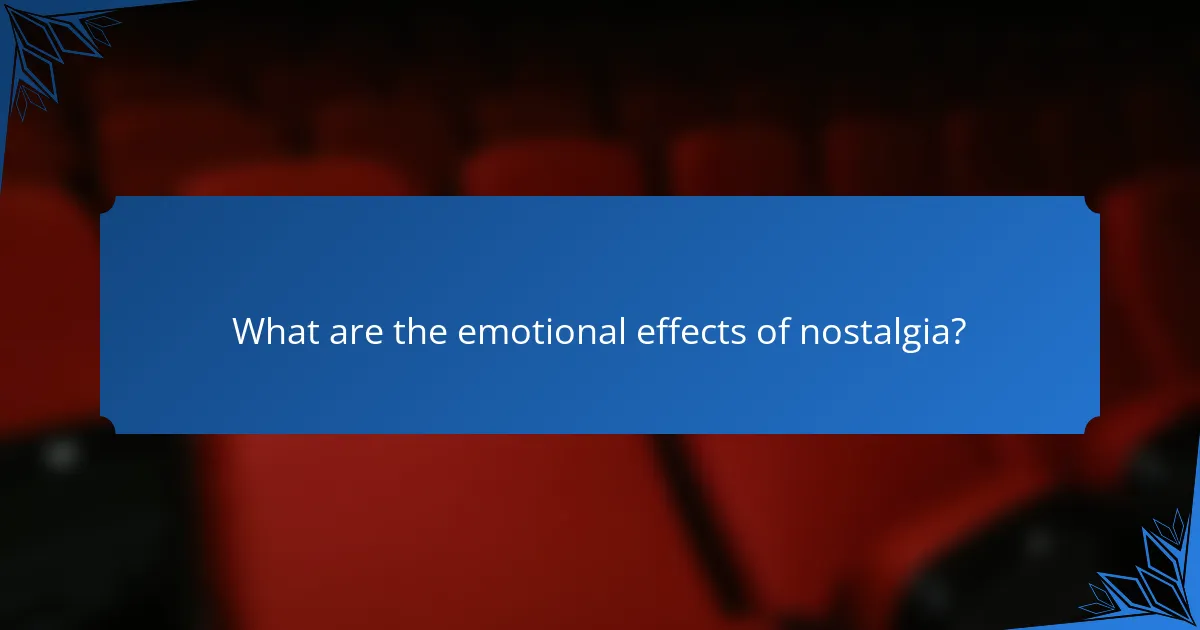
What are the emotional effects of nostalgia?
Nostalgia has significant emotional effects, primarily enhancing feelings of happiness and reducing feelings of loneliness. It serves as a psychological mechanism that connects individuals to cherished memories, often leading to improved mood and emotional well-being.
Increases feelings of happiness
Nostalgia can boost happiness by allowing individuals to reminisce about positive past experiences. This reflection often triggers feelings of warmth and joy, as people recall moments that brought them pleasure or fulfillment.
Engaging in nostalgic activities, such as looking through old photographs or listening to music from one’s youth, can elevate mood. These activities often evoke a sense of belonging and continuity, reinforcing a positive self-image.
Reduces feelings of loneliness
Nostalgia can serve as a powerful antidote to loneliness by fostering connections to the past and to others. When individuals reflect on shared experiences, they often feel a sense of belonging, even if those people are no longer present in their lives.
Participating in nostalgic practices, like storytelling or group discussions about shared memories, can help individuals feel more connected to their social circles. This connection can alleviate feelings of isolation and promote emotional resilience.

How does nostalgia shape personal identity?
Nostalgia plays a significant role in shaping personal identity by connecting individuals to their past experiences and emotions. It fosters a sense of continuity and belonging, allowing people to integrate their memories into a coherent self-concept.
Strengthens self-continuity
Nostalgia enhances self-continuity by linking past experiences to the present self. When individuals reflect on positive memories, they reinforce their sense of who they are and where they come from. This connection can be particularly powerful during transitional life stages, such as moving to a new city or starting a new job.
For example, reminiscing about childhood experiences can help adults navigate current challenges by providing a sense of stability and reassurance. Engaging with nostalgic memories can remind individuals of their core values and beliefs, further solidifying their identity over time.
Influences life narrative
Nostalgia influences life narrative by shaping how individuals interpret their past and present experiences. The stories people tell about themselves often reflect nostalgic themes, highlighting moments of joy, connection, and growth. This narrative construction helps individuals make sense of their life journey and fosters a positive self-image.
In practice, individuals can benefit from actively incorporating nostalgic memories into their life stories. This could involve journaling about significant past events or sharing stories with friends and family. By doing so, they can create a richer, more meaningful narrative that reinforces their identity and enhances emotional well-being.

What are the therapeutic uses of nostalgia?
Nostalgia has therapeutic uses that can enhance emotional well-being and foster connections to one’s identity. By evoking positive memories, nostalgia can serve as a tool in various therapeutic settings, helping individuals cope with challenges and improve their mental health.
Used in reminiscence therapy
Reminiscence therapy leverages nostalgia to help individuals, particularly the elderly, recall and share memories from their past. This practice can stimulate cognitive function and improve mood by connecting clients with their life stories. For example, therapists may encourage discussions about significant life events, family traditions, or favorite pastimes to promote engagement and reflection.
In group settings, reminiscence therapy can foster social interaction and reduce feelings of isolation. Participants often find comfort in shared experiences, which can strengthen community bonds and enhance emotional support among peers.
Promotes emotional healing
Nostalgia can play a significant role in emotional healing by providing a sense of comfort and belonging. Engaging with nostalgic memories can evoke feelings of happiness and security, which can counteract negative emotions such as anxiety or depression. For instance, recalling joyful moments from childhood can help individuals reconnect with a sense of innocence and joy.
Additionally, nostalgia can serve as a coping mechanism during difficult times. By reflecting on positive past experiences, individuals can gain perspective and resilience, making it easier to navigate current challenges. It is essential, however, to balance nostalgia with present experiences to avoid excessive longing for the past.

How does nostalgia vary across cultures?
Nostalgia manifests differently across cultures, influenced by social norms, historical contexts, and collective memories. While it often evokes positive emotions and a sense of belonging, the specific triggers and expressions can vary significantly between Western and Eastern societies.
Different triggers in Western cultures
In Western cultures, nostalgia is frequently triggered by personal milestones, such as childhood memories, significant life events, or cultural artifacts like music and films. These triggers often evoke feelings of warmth and longing, reinforcing individual identity and personal history.
Common examples include reunions, anniversaries, and nostalgic marketing campaigns that leverage familiar songs or imagery. These experiences can lead to increased emotional well-being, as individuals reconnect with their past and share stories with others.
Unique expressions in Eastern cultures
In Eastern cultures, nostalgia often intertwines with collective memory and social harmony, reflecting communal experiences rather than just individual ones. Traditional festivals, family gatherings, and historical events serve as powerful nostalgia triggers, emphasizing shared heritage and cultural continuity.
For instance, festivals like the Mid-Autumn Festival in China evoke nostalgia through storytelling and family reunions, reinforcing bonds and cultural identity. This communal aspect can foster a sense of belonging and emotional support, highlighting the importance of relationships in nostalgic experiences.

What role does nostalgia play in advertising?
Nostalgia in advertising serves to create a connection between consumers and brands by tapping into fond memories and emotions. This emotional engagement can significantly influence purchasing decisions and brand perception.
Evokes emotional connections
Nostalgia evokes emotional connections by reminding consumers of positive past experiences. Advertisements that feature familiar music, imagery, or themes can trigger memories that resonate personally with the audience. For example, a commercial showcasing a classic toy from the 1980s can transport viewers back to their childhood, fostering a sense of warmth and familiarity.
This emotional resonance can be particularly effective in campaigns targeting older demographics, who may have stronger ties to certain cultural references. By leveraging these connections, brands can create a more impactful message that feels relevant and meaningful.
Enhances brand loyalty
Nostalgia can enhance brand loyalty by reinforcing a sense of identity and belonging among consumers. When a brand successfully evokes nostalgia, it can create a lasting emotional bond that encourages repeat purchases. For instance, a beverage company that incorporates retro packaging or nostalgic advertising themes may attract customers who associate the brand with positive memories.
Additionally, brands that consistently use nostalgic elements in their marketing can cultivate a loyal following. Consumers are likely to return to brands that remind them of cherished moments, making nostalgia a powerful tool for customer retention and engagement.

What are the potential downsides of nostalgia?
Nostalgia can have several downsides, including fostering a tendency to escape reality and creating dissatisfaction with current circumstances. While it can evoke positive emotions, it may also lead to negative psychological outcomes if relied upon excessively.
Can lead to escapism
Nostalgia can encourage escapism by prompting individuals to retreat into idealized memories rather than confronting present challenges. This tendency may result in avoiding responsibilities or necessary changes in life, as individuals seek comfort in the past.
For example, someone might spend excessive time reminiscing about their college days instead of addressing current career dissatisfaction. This avoidance can hinder personal growth and lead to stagnation.
May cause dissatisfaction with the present
Engaging in nostalgic reflection can sometimes create a sense of longing for a past that may not have been as perfect as remembered. This can lead to feelings of inadequacy or unhappiness with one’s current life situation, as individuals compare their present to an idealized past.
For instance, a person might feel discontent with their current relationships if they constantly compare them to past friendships that seemed more fulfilling. Recognizing this pattern is crucial to fostering a healthier perspective on both the past and present.
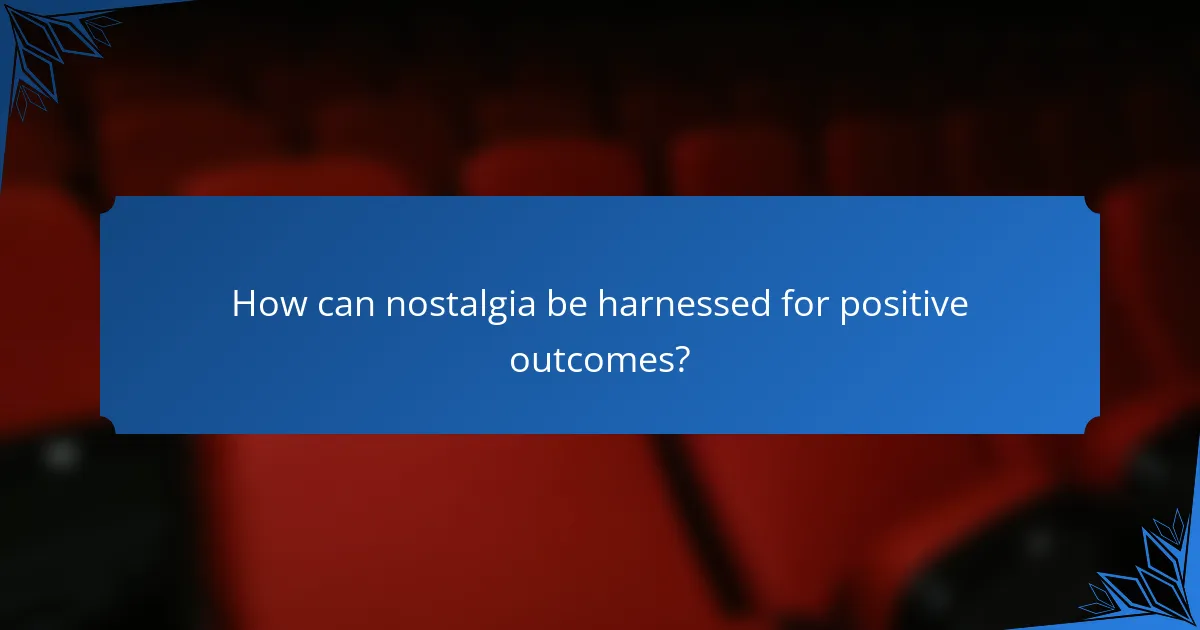
How can nostalgia be harnessed for positive outcomes?
Nostalgia can be effectively harnessed to evoke positive emotions and strengthen connections with individuals or brands. By creating experiences that trigger nostalgic feelings, organizations can enhance customer loyalty and improve overall well-being.
Creating nostalgic experiences in marketing
Marketers can create nostalgic experiences by tapping into shared memories and cultural references that resonate with their target audience. This can involve using retro designs, familiar jingles, or storytelling that recalls simpler times, making the brand more relatable and memorable.
For example, a beverage company might reintroduce a classic product from the past, accompanied by advertisements that highlight its history. This strategy not only rekindles fond memories but also encourages consumers to associate those positive feelings with the brand.
To effectively implement nostalgia in marketing, consider the following tips: focus on authenticity, ensure the nostalgic elements align with the brand’s identity, and avoid over-saturation. Balancing nostalgia with modern relevance can create a compelling narrative that attracts both older and younger consumers.
